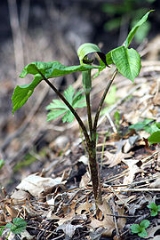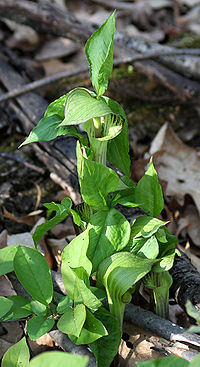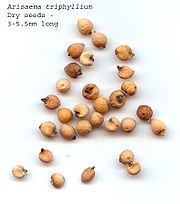
Arisaema triphyllum
Encyclopedia
Arisaema triphyllum is a herbaceous
perennial plant
growing from a corm
. It is a highly variable species typically growing from 30 to 65 cm in height with three parted leaves and flowers contained in a spadix that is covered by a hood. It is native to eastern North America
, occurring in moist woodlands and thickets from Nova Scotia
west to Minnesota
, and south to southern Florida
.

 The leaves
The leaves
are trifoliate, with groups of three leaves growing together at the top of one long stem produced from a corm
; each leaflet is 8-15 cm long and 3-7 cm broad. Plants are sometimes confused with Poison-ivy especially before the flowers appear or non-flowering plants. The inflorescence
s are shaped irregularly and grow to a length of up to 8 cm long. They are greenish-yellow with purple or brownish stripes. The spathe, known in this plant as "the pulpit" wraps around and covers over and contain a spadix
("Jack"), covered with tiny flowers of both sexes. The flowers are unisexual, in small plants most if not all the flowers are male, as plants age and grow larger the spadix produces more female flowers. This species flowers from April to June. It is pollinated by flies, which it attracts using heat and smell. The fruit
are smooth, shiny green, 1 cm wide berries
clustered on the thickened spadix. The fruits ripen in late summer and fall, turning a bright red color before the plants go dormant. Each berry produces 1 to 5 seeds typically, the seeds are white to light tan in color, rounded, often with flattened edges and a short sharp point at the top and a rounded bottom surface.
If the seeds are freed from the berry they will germinate the next spring, producing a plant with a single rounded leaf. Seedlings need three or more years of growth before they become large enough to flower.
In addition the plant is not self pollinating since the male flowers on a specific plant have already matured and died before the female flowers of that same plant are mature. So the female flowers need to be pollinated by the male flowers of a different plant. This inhibits inbreeding and contributes to the health of the species.
It is hardy to USDA plant hardiness zone 3.


 The plant contains calcium oxalate
The plant contains calcium oxalate
crystals as raphides in all parts, and because of this consumption of the raw plant material results in a powerful burning sensation. It can cause irritation of the mouth and digestive system, and on rare occasions the swelling of the mouth and throat may be severe enough to affect breathing.
If the plant is properly dried or cooked it can be eaten as a root vegetable.
A preparation of the root was reported to have been used by Native Americans
as a treatment for sore eyes. Preparations were also made to treat rheumatism
, bronchitis
, and snakebites, as well as to induce sterility.
Indians states that they would chop the herb's corm and mix it with meat and leave the meat out for their enemies to find. The taste of the oxalate would not be detectable because of the flavored meat, but consuming the meat reportedly caused their enemies pain and death. They also used it to determine the fate of the sick by dropping a seed in a cup of stirred water; If the seed went around four times clockwise, the patient would recover, if it went around less than four times they would not.
in jack in the pulpit is poisonous if ingested.
Care should also be taken to avoid confusion with poison ivy
, which has 3 leaflets somewhat similar in appearance.
Within the genus Arisaema, A. triphyllum is classified in the section Pedatisecta and is most closely related to Asian species such as A. amurense.
It is not a close relative to the other American Arisaema species (the North American A. dracontium
and the Mexican A. macrophyllum), which are in a different section of Arisaema.
Herbaceous
A herbaceous plant is a plant that has leaves and stems that die down at the end of the growing season to the soil level. They have no persistent woody stem above ground...
perennial plant
Perennial plant
A perennial plant or simply perennial is a plant that lives for more than two years. The term is often used to differentiate a plant from shorter lived annuals and biennials. The term is sometimes misused by commercial gardeners or horticulturalists to describe only herbaceous perennials...
growing from a corm
Corm
A corm is a short, vertical, swollen underground plant stem that serves as a storage organ used by some plants to survive winter or other adverse conditions such as summer drought and heat ....
. It is a highly variable species typically growing from 30 to 65 cm in height with three parted leaves and flowers contained in a spadix that is covered by a hood. It is native to eastern North America
North America
North America is a continent wholly within the Northern Hemisphere and almost wholly within the Western Hemisphere. It is also considered a northern subcontinent of the Americas...
, occurring in moist woodlands and thickets from Nova Scotia
Nova Scotia
Nova Scotia is one of Canada's three Maritime provinces and is the most populous province in Atlantic Canada. The name of the province is Latin for "New Scotland," but "Nova Scotia" is the recognized, English-language name of the province. The provincial capital is Halifax. Nova Scotia is the...
west to Minnesota
Minnesota
Minnesota is a U.S. state located in the Midwestern United States. The twelfth largest state of the U.S., it is the twenty-first most populous, with 5.3 million residents. Minnesota was carved out of the eastern half of the Minnesota Territory and admitted to the Union as the thirty-second state...
, and south to southern Florida
Florida
Florida is a state in the southeastern United States, located on the nation's Atlantic and Gulf coasts. It is bordered to the west by the Gulf of Mexico, to the north by Alabama and Georgia and to the east by the Atlantic Ocean. With a population of 18,801,310 as measured by the 2010 census, it...
.
Description


Leaf
A leaf is an organ of a vascular plant, as defined in botanical terms, and in particular in plant morphology. Foliage is a mass noun that refers to leaves as a feature of plants....
are trifoliate, with groups of three leaves growing together at the top of one long stem produced from a corm
Corm
A corm is a short, vertical, swollen underground plant stem that serves as a storage organ used by some plants to survive winter or other adverse conditions such as summer drought and heat ....
; each leaflet is 8-15 cm long and 3-7 cm broad. Plants are sometimes confused with Poison-ivy especially before the flowers appear or non-flowering plants. The inflorescence
Inflorescence
An inflorescence is a group or cluster of flowers arranged on a stem that is composed of a main branch or a complicated arrangement of branches. Strictly, it is the part of the shoot of seed plants where flowers are formed and which is accordingly modified...
s are shaped irregularly and grow to a length of up to 8 cm long. They are greenish-yellow with purple or brownish stripes. The spathe, known in this plant as "the pulpit" wraps around and covers over and contain a spadix
Spadix
In botany, a spadix is a type of spike inflorescence having small flowers borne on a fleshy stem. Spadix are typical of the Family Araceae known as arums or aroids...
("Jack"), covered with tiny flowers of both sexes. The flowers are unisexual, in small plants most if not all the flowers are male, as plants age and grow larger the spadix produces more female flowers. This species flowers from April to June. It is pollinated by flies, which it attracts using heat and smell. The fruit
Fruit
In broad terms, a fruit is a structure of a plant that contains its seeds.The term has different meanings dependent on context. In non-technical usage, such as food preparation, fruit normally means the fleshy seed-associated structures of certain plants that are sweet and edible in the raw state,...
are smooth, shiny green, 1 cm wide berries
Berry
The botanical definition of a berry is a fleshy fruit produced from a single ovary. Grapes are an example. The berry is the most common type of fleshy fruit in which the entire ovary wall ripens into an edible pericarp. They may have one or more carpels with a thin covering and fleshy interiors....
clustered on the thickened spadix. The fruits ripen in late summer and fall, turning a bright red color before the plants go dormant. Each berry produces 1 to 5 seeds typically, the seeds are white to light tan in color, rounded, often with flattened edges and a short sharp point at the top and a rounded bottom surface.
If the seeds are freed from the berry they will germinate the next spring, producing a plant with a single rounded leaf. Seedlings need three or more years of growth before they become large enough to flower.
In addition the plant is not self pollinating since the male flowers on a specific plant have already matured and died before the female flowers of that same plant are mature. So the female flowers need to be pollinated by the male flowers of a different plant. This inhibits inbreeding and contributes to the health of the species.
It is hardy to USDA plant hardiness zone 3.
Chemical composition and medicinal uses



Calcium oxalate
Calcium oxalate is a chemical compound that forms needle-shaped crystals, known in plants as raphides. A major constituent of human kidney stones, the chemical is also found in beerstone, a scale that forms on containers used in breweries...
crystals as raphides in all parts, and because of this consumption of the raw plant material results in a powerful burning sensation. It can cause irritation of the mouth and digestive system, and on rare occasions the swelling of the mouth and throat may be severe enough to affect breathing.
If the plant is properly dried or cooked it can be eaten as a root vegetable.
A preparation of the root was reported to have been used by Native Americans
Indigenous peoples of the Americas
The indigenous peoples of the Americas are the pre-Columbian inhabitants of North and South America, their descendants and other ethnic groups who are identified with those peoples. Indigenous peoples are known in Canada as Aboriginal peoples, and in the United States as Native Americans...
as a treatment for sore eyes. Preparations were also made to treat rheumatism
Rheumatism
Rheumatism or rheumatic disorder is a non-specific term for medical problems affecting the joints and connective tissue. The study of, and therapeutic interventions in, such disorders is called rheumatology.-Terminology:...
, bronchitis
Bronchitis
Acute bronchitis is an inflammation of the large bronchi in the lungs that is usually caused by viruses or bacteria and may last several days or weeks. Characteristic symptoms include cough, sputum production, and shortness of breath and wheezing related to the obstruction of the inflamed airways...
, and snakebites, as well as to induce sterility.
History and folklore
One account from the MeskwakiMeskwaki
The Meskwaki are a Native American people often known to outsiders as the Fox tribe. They have often been closely linked to the Sauk people. In their own language, the Meskwaki call themselves Meshkwahkihaki, which means "the Red-Earths." Historically their homelands were in the Great Lakes region...
Indians states that they would chop the herb's corm and mix it with meat and leave the meat out for their enemies to find. The taste of the oxalate would not be detectable because of the flavored meat, but consuming the meat reportedly caused their enemies pain and death. They also used it to determine the fate of the sick by dropping a seed in a cup of stirred water; If the seed went around four times clockwise, the patient would recover, if it went around less than four times they would not.
Warning
The oxalic acidOxalic acid
Oxalic acid is an organic compound with the formula H2C2O4. This colourless solid is a dicarboxylic acid. In terms of acid strength, it is about 3,000 times stronger than acetic acid. Oxalic acid is a reducing agent and its conjugate base, known as oxalate , is a chelating agent for metal cations...
in jack in the pulpit is poisonous if ingested.
Care should also be taken to avoid confusion with poison ivy
Poison ivy
Toxicodendron radicans, better known as poison ivy , is a poisonous North American plant that is well known for its production of urushiol, a clear liquid compound found within the sap of the plant that causes an itching rash in most people who touch it...
, which has 3 leaflets somewhat similar in appearance.
Classification and relationships
A. triphyllum is generally considered to be a single species with three subspecies. A. triphyllum subsp. stewardsonii and A. triphyllum subsp. pusillum are diploids, and A. triphyllum subsp. triphyllum is a tetraploid which originated as a hybrid of the first two. However, the three are reproductively isolated in the wild, which would argue for treating them as species. The main reason for considering them subspecies seems to be the difficulty in distinguishing them, especially based on herbarium specimens.Within the genus Arisaema, A. triphyllum is classified in the section Pedatisecta and is most closely related to Asian species such as A. amurense.
It is not a close relative to the other American Arisaema species (the North American A. dracontium
Arisaema dracontium
Arisaema dracontium is a herbaceous perennial plant in the genus Arisaema and the family Araceae. It is native to North America from Quebec to Minnesota South to Florida and Texas, where it is found growing in damp woods. Plants grow 20–50 cm tall when in bloom and after flowering reach...
and the Mexican A. macrophyllum), which are in a different section of Arisaema.

